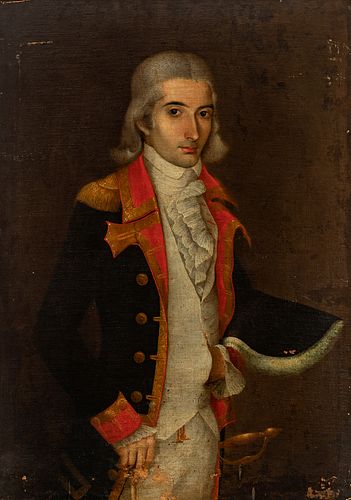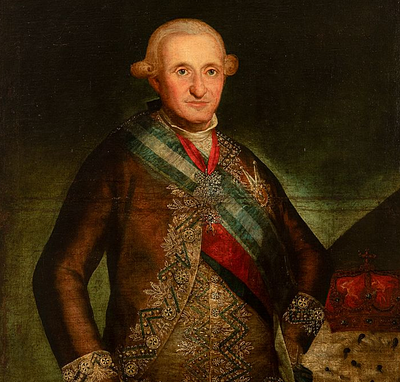Novo-Hispanic master or Puerto Rico, ca. 1790. "Possible portrait of Cosme Damián de Churruca". Oil on canvas. Relined
Lot 37
About Seller
Setdart Auction House
Carrer Aragó 346
Barcelona
Spain
Setdart Subastas was born in 2004 and is currently the first online art auction in Spain with solidity, prestige and reliability guaranteed by our more than 60,000 users. Setdart has a young, dynamic and enterprising team ready to successfully manage the purchase and sale of art works through custom...Read more
Estimate:
EUR€16,000 - EUR€18,000
$17,204.30 - $19,354.84
Absentee vs Live bid
Two ways to bid:
- Leave a max absentee bid and the platform will bid on your behalf up to your maximum bid during the live auction.
- Bid live during the auction and your bids will be submitted real-time to the auctioneer.
Bid Increments
| Price | Bid Increment |
|---|---|
| EUR€0 | EUR€10 |
| EUR€200 | EUR€25 |
| EUR€500 | EUR€50 |
| EUR€1,000 | EUR€100 |
| EUR€3,000 | EUR€200 |
| EUR€5,000 | EUR€500 |
| EUR€10,000 | EUR€1,000 |
| EUR€20,000 | EUR€2,000 |
| EUR€50,000 | EUR€5,000 |
About Auction
By Setdart Auction House
Sep 22, 2021
Set Reminder
2021-09-22 09:30:00
2021-09-22 09:30:00
America/New_York
Bidsquare
Bidsquare : 22nd September - ARAS JÁUREGUI Private Collection - Old Masters, 19th & 20th Century
https://www.bidsquare.com/auctions/setdart-auction-house/22nd-september---aras-j-uregui-private-collection---old-masters-19th-20th-century-7427
ARAS JÁUREGUI Private Collection - Old Masters, 19th & 20th Century Setdart Auction House sofia@setdart.com
ARAS JÁUREGUI Private Collection - Old Masters, 19th & 20th Century Setdart Auction House sofia@setdart.com
- Lot Description
Novo-Hispanic master or Puerto Rico, ca. 1790. "Possible portrait of Cosme Damián de Churruca". Oil on canvas. Relined It presents repainting and restorations. Measurements: 97 x 68 cm. In this work the artist presents us with an exceptional portrait of a naval officer. This characteristic can be deduced from the uniform in which he is dressed. The sitter is standing before the viewer, slightly turned three-quarters of the way round, leaning on a cane. Despite his position, the sitter is looking at the viewer with a serious, rigid gesture, which is defined by the position of his lips, which are closed and pressed together, and his eyebrows arched in an attentive position. In such a way that he seems not only to show his social relevance to the spectator, but also to reveal his interest in the one who observes him, thus establishing a dialogue, where his regal pose defines his preponderant situation. From the aforementioned clothing and physical features, it is possible that this is a portrait of the scientist and Brigadier of the navy Don Cosme Damián Churruca y Elorza (Guipúzcoa, 1761 - Cadiz, 1805). A renowned marine, Churruca entered the Cadiz Naval Academy in 1776, although two years later he graduated from the Ferrol Naval Academy as an officer. During his professional career, he took part in the siege of Gibraltar between 1781-1782. Years later, his knowledge as a scientist earned him the opportunity to take part in the expedition commanded by Antonio Córdova in the Strait of Magellan, and on his return, Churruca was responsible for directing the campaign designed to reform the maritime atlas of North America. In 1802 he settled in Mutriko (Guipúzcoa), where he served as mayor until 1805, when he became involved in the war with England, taking part in the battle of Trafalgar, where he was wounded and killed in combat. Churruca's work in the military and scientific fields earned him a great social reputation, making him one of the most highly valued figures of the time. His knowledge of mathematics, mechanics and astronomy, together with his publications on his various research projects, made him a great intellectual of the time. In terms of aesthetics, the work follows the aesthetic patterns typical of the portraitist of the time. The figure in the foreground, against a neutral background that does not distort the figure of the protagonist, etc. It is worth mentioning that, during Spanish colonial rule, a style of painting developed in which local painters were modelled on Spanish works, which they followed literally in terms of type and iconography. However, in the early years of the 19th century, at the time of independence and the political opening up of some of the colonies, several artists began to represent a new model of painting with its own identity.
- Shipping Info
-
In-house shipping available. Please inquire at admin@setdart.com.
-
- Buyer's Premium



 EUR
EUR CAD
CAD AUD
AUD GBP
GBP MXN
MXN HKD
HKD CNY
CNY MYR
MYR SEK
SEK SGD
SGD CHF
CHF THB
THB

















